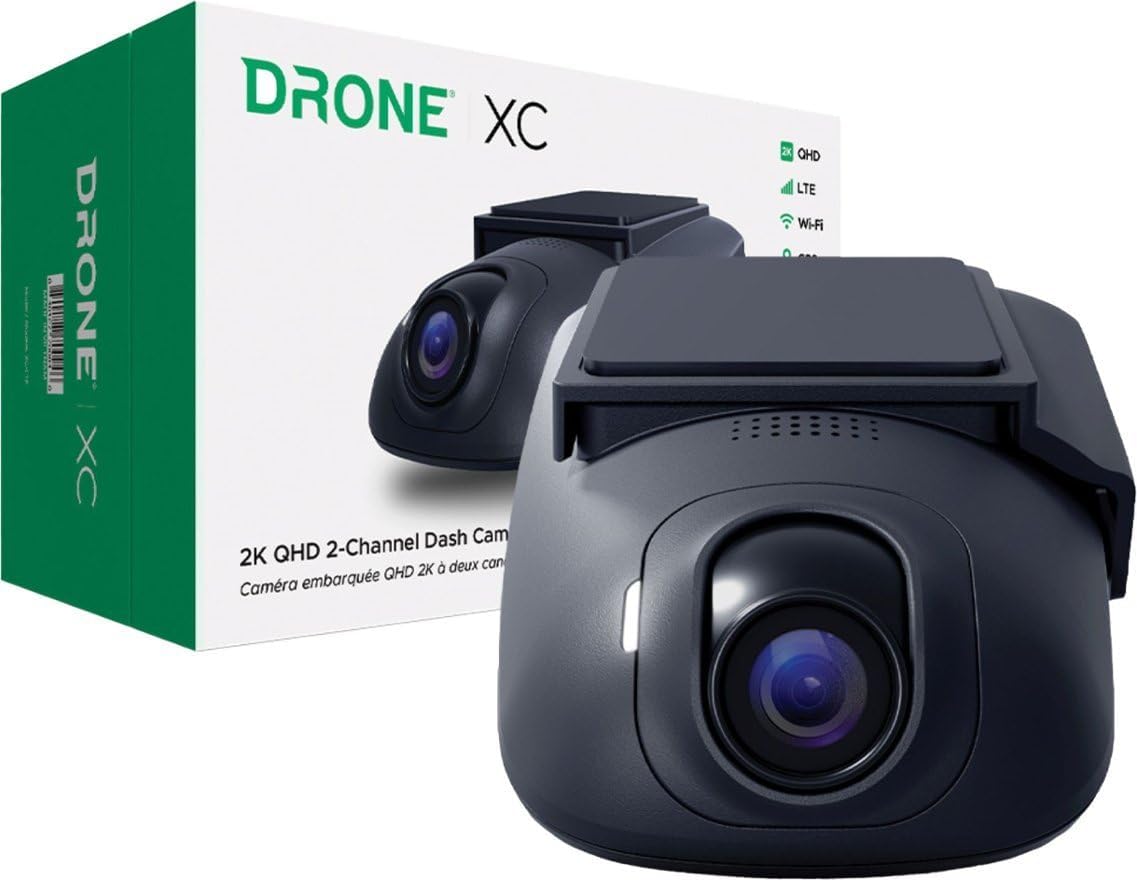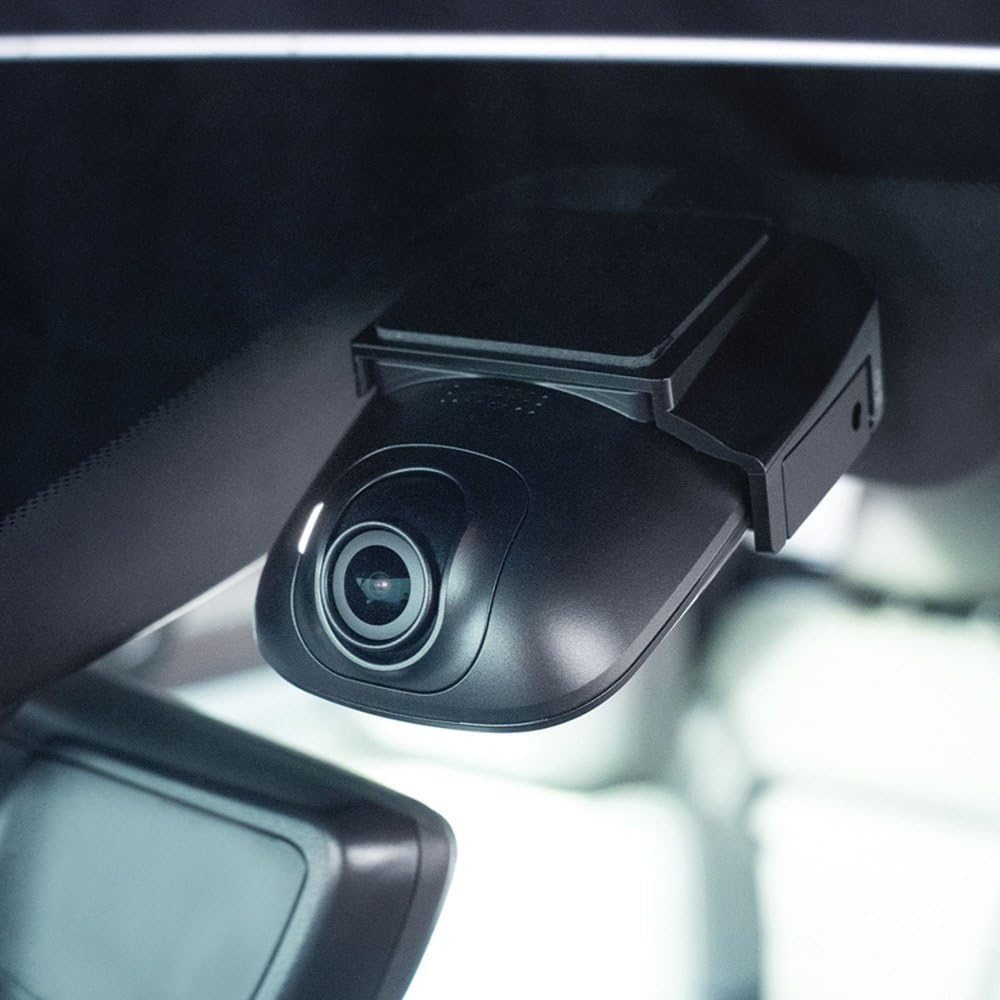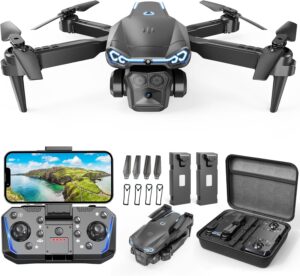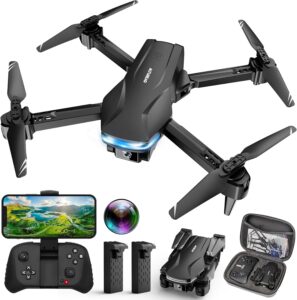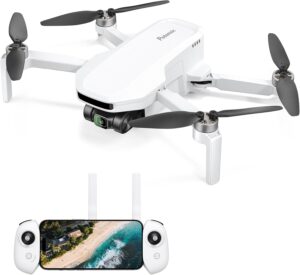Can we write in the exact style of David Sedaris? We can’t, but we’ll craft an original review with a witty, observational, first-person-plural voice that keeps things light, dry, and friendly.
Why we wanted a dash camera that actually pulls its weight
We’ve all had that moment when a horn honks, a blinker blinks, and we’re left wishing the universe came with a replay button. That’s the day-to-day unease that got us thinking about a dash camera. Not a toy or a fad, but something that would calmly collect the little truths of highway life—without turning our windshield into a cluttered art installation.
We wanted a compact, reliable, always-on witness that could watch our vehicle when we’re driving and when we’ve walked away. And if it could talk with our aftermarket remote start and security system, even better. That’s how we arrived at the Drone XC 2K LTE/Wi-Fi/GPS Dash Camera with aftermarket Remote Start & Security Alarm System Integration—a mouthful, yes, but also the kind of tech that promises to make our time on and off the road less mystery and more clarity.
Drone XC 2K LTE/Wi-Fi/GPS Dash Camera with aftermarket Remote Start & Security Alarm System Integration
What the Drone XC 2K LTE/Wi-Fi/GPS Dash Camera is, in plain language
At its core, the Drone XC is a compact 2K front-facing dash camera. It records from the moment we start driving to the moment we turn the ignition off. It uses a Sony STARVIS sensor and provides a 154-degree field of view. It has LTE, Wi-Fi, and GPS capabilities. And it connects to an aftermarket remote start or security system so that monitoring doesn’t stop just because the car isn’t moving.
It’s designed to keep a low profile on the windshield, sticking up there without shouting for attention. It’s the sort of thing that hopes to be ignored until the exact moment it’s needed. When that time comes, it should deliver footage that’s crisp enough to read signs and see faces, steady enough to tell a story, and smart enough to tag location and time.
What it promises to do for us
From the brand’s positioning and the product details, the Drone XC is meant to:
- Record our drives automatically from engine-on to engine-off.
- Keep an eye on things when our vehicle’s security system detects something.
- Provide wide, 2K, STARVIS-enhanced clarity of what’s in front of us.
- Connect over LTE, Wi-Fi, and GPS to keep our footage and alerts tied to place and time.
- Integrate with the aftermarket remote start and alarm setup we already rely on.
Key specs at a glance
The basics matter, especially when we’re choosing something that gets front-row seating in our car. Here’s a quick breakdown.
| Feature | What it means for us | Why it matters |
|---|---|---|
| 2K front camera (Sony STARVIS) | Higher-than-1080p detail with enhanced low-light performance | Better clarity for plates, signs, and faces—day or night |
| 154° field of view | Wide coverage without severe distortion | Captures more lanes and sidewalks; reduces blind spots in footage |
| LTE connectivity | Cellular-based access and alerts (typically requires a data plan) | We can get updates without being near the car or a Wi-Fi network |
| Wi-Fi connectivity | Local wireless access for our phone | Faster clip transfer and firmware updates when we’re nearby |
| GPS | Location tagging and contextual data | Places our footage on a map and provides helpful trip context |
| Aftermarket remote start/security integration | Hooks into our existing system | Camera awareness even when the car is parked and locked |
| Small windshield footprint | Minimal visual obstruction | Doesn’t draw attention; blends into the cabin |
We like products that know their role. The Drone XC doesn’t pretend to be a movie studio on a suction cup; it wants to be a reliable witness, show up when called, and then quietly recede into the background.
Setup and installation without the stress headache
We’re not auditioning to be auto electricians, but we do appreciate when a product respects our time and skill level. The Drone XC’s setup flow is typical of modern dash cams with added attention to integration.
In broad strokes, installation looks like this:
- Mount the camera on the windshield behind or near the rearview mirror.
- Route the cable along the headliner and A-pillar to power and, if integrating, to the aftermarket remote start/security control module.
- Configure LTE/Wi-Fi/GPS settings via the companion process (usually through an app and/or guided prompts).
- Confirm recording starts with ignition and that alert triggers (from the alarm system) reach the camera as designed.
If we’re already running an aftermarket remote start or alarm, we’re likely familiar with the control module tucked under the dash. The Drone XC’s integration means it can listen for relevant events—such as door/impact triggers—from that system. If we’re not comfortable splicing or pin-fitting harnesses, we plan on a pro install. There’s no shame in delegating car-wiring to someone who enjoys a Saturday spent with a multimeter.
Windshield placement and the blessing of a small footprint
We’re big fans of mounting anything high and centered, usually behind the rearview mirror. That keeps the camera’s body out of our direct line of sight, and it disguises it nicely from prying eyes on the sidewalk. The Drone XC’s small footprint helps here; it blends, rather than broadcasts.
We recommend:
- Cleaning the glass with alcohol before sticking the mount.
- Sitting in the driver’s seat and confirming the lens has a clear, unobstructed view.
- Checking local regulations, since some areas have specific rules about where cameras can be mounted on the windshield.
App and connectivity setup
The LTE/Wi-Fi/GPS trio suggests a setup flow involving a mobile device. While details vary, the usual steps include:
- Pairing the camera to our phone over Bluetooth or Wi-Fi.
- Adding LTE service if we want off-site alerts and remote connectivity (cellular features often require a data plan through the vendor or a partner).
- Verifying GPS is enabled and accurate by taking a short test drive.
Once configured, we should see consistent recording from engine-on to engine-off and get the kind of location-tagged clips that make sense after the fact. When we’re parked, integration with the aftermarket security system means the camera isn’t pretending the day is done.
Daily driving with the 2K Sony STARVIS camera
The sensor and resolution are the practical heart of the Drone XC. That 2K resolution gives us more detail than plain 1080p, and the Sony STARVIS sensor is known for its low-light chops. In practice, this means finer detail in signage, smoother edges on moving objects, and less guesswork when it comes time to identify something important.
We appreciate that the camera’s mission is to get the truth down without fuss. Compression and bitrates vary across devices, but in a 2K class camera with a STARVIS sensor, we expect daylight to fall into place cleanly, and nighttime to present its fair share of noise that’s still manageable and useful.
Daytime performance
On a sunny day, this camera is in its element. The 2K capture gives us crisp outlines on cars, bikes, and pedestrians. License plates are more readily legible at a reasonable distance than they tend to be on 1080p systems, especially when traffic’s moving. We’ve all paused a clip and wished for one more smidge of sharpness—that’s where 2K earns its keep.
Glare management depends on lens coating and HDR tuning. We’ve learned to angle the camera slightly down to avoid capturing too much sky, which helps with exposure across the scene. The 154-degree field of view is wide enough to snag the action that starts in our peripheral vision and gallops into the center frame, yet restrained enough that it doesn’t stretch cars into funhouse proportions at the edges.
Nighttime performance
Night, rain, and neon signage are the final exam for a dash camera. The STARVIS sensor is built to stay sensitive in low light, which can pull more detail out of dimly lit scenes and headlight-only roadways. We don’t expect miracles at 55 mph on an unlit highway, but we do look for intelligible motion, readable timeline context, and an overall picture that holds together long enough to be meaningful later.
In stop-and-go traffic, parking lots, or well-lit streets, the Drone XC’s specs point to clarity that holds up. It’s these moments—the driveway bump, the late-night tap on a bumper—that benefit most from a sensor designed to keep the shadows from swallowing everything.
The 154-degree field of view and why that number matters
There’s a sweet spot in dash cams between too narrow (where we miss what’s happening in the next lane) and too wide (where edges distort and depth is hard to judge). At 154 degrees, the Drone XC aims for that balance: wide enough to cover multi-lane city scenes, angled enough to capture sidewalks and crosswalks, and yet still coherent in the center frame.
This is particularly useful at four-way stops and for catching the beginnings of events—think of a car merging too enthusiastically from the right or a cyclist passing just as the light turns. We want the clip to show not just what happened but how we arrived there.
On- and off-road monitoring that doesn’t clock out early
A lot of dash cameras are diligent while we’re driving and then lose interest when we park. The Drone XC is noteworthy for staying engaged. Its promise to “monitor your vehicle on and off the road” translates to continuity: we don’t have to wonder if the camera was paying attention when an alarm triggers or when something jostles the car.
We appreciate that the camera records from the moment we start driving to the moment the ignition turns off. That continuity means no digging through clip lists for a missing first minute, no shrugging when something happens right after we pull away from a curb. It’s simple, and it’s the kind of predictability we count on when reviewing footage later.
When the car is off, the integration with an aftermarket security system is the glue. If our alarm system reports a door open, an impact, or another trigger event, the camera can be part of the response. We like the idea of having video that lines up with the instant someone tugged on a handle or bumped the bumper. The day we don’t need it, great. The day we do, it’s worth its weight.
Aftermarket remote start and security system integration: the quiet superpower
Let’s be honest: the aftermarket remote start is one of those “once we have it, we won’t go back” conveniences. Warm car in winter, cool in summer, and just the right amount of smugness when we press the button. Integrating a dash camera into that setup means the camera gets smarter about context.
Here are some real-world benefits we’ve found compelling:
- Alarm-trigger awareness: If our security system senses an event, the camera is poised to capture related footage.
- Routine consistency: Because the camera starts recording at ignition-on and stops at ignition-off, remote start sessions are recorded as part of our normal usage pattern.
- Fewer gaps: Events triggered by the alarm system can be aligned with clips, so we’re not piecing together a timeline from guesswork.
When the camera and security system become friends, we get a cleaner record of what happened, when, and where. That’s good for insurance conversations and great for our peace of mind.
Who this integration is for (and who can skip it)
- Ideal for us if:
- We already have an aftermarket remote start or alarm and want the camera to cooperate with it.
- We park on streets, in shared garages, or in places where small mysteries occur with big consequences.
- We prefer our camera to be a team player rather than a solo act.
- Maybe not necessary if:
- Our car sleeps in a locked garage that might as well be a vault.
- We don’t have an aftermarket system and don’t plan on adding one.
LTE, Wi-Fi, and GPS: the trio that matters more than we think
Cameras are only as useful as the stories they can tell us, and the Drone XC’s connectivity options help those stories make sense.
- LTE gives us the ability to interact with our camera beyond Bluetooth’s short leash. It’s what enables the “check in even when we’re away” mindset. We can receive alerts and, depending on the service, access features without being near the car.
- Wi-Fi is our local budget airline—perfect for on-the-spot downloads, configuration changes, and firmware updates while we stand next to the car with our phone.
- GPS anchors our clips in the real world. A time and place stamp saves us from squinting at street signs in the background of a video and lets us recall routes accurately.
Data and privacy considerations
Most LTE-enabled gear requires some type of data plan. That can be a small monthly fee through the manufacturer or a partner provider. We like to budget for that when shopping rather than be surprised later. As for privacy, we treat dash cams like any connected device: we set strong passwords, keep firmware updated, and review data-sharing settings carefully.
We also keep in mind that GPS location tagging is handy for our own records but should be managed thoughtfully. When we share clips, we check whether we want to include location data.
Storage and clip management without playing archaeologist
We care about how clips are stored and found later. While specific storage details can vary, most dash cameras in this class use local memory with loop recording. That means the camera continuously records and overwrites the oldest clips when storage is full, unless a clip is protected (for example, flagged by a trigger or manually locked).
Our approach:
- Treat important clips like important texts—save and back them up quickly.
- Offload over Wi-Fi when we’re near the car if a clip matters now.
- Organize saved clips by date and tag them with a few plain-English labels (e.g., “parking lot incident” or “construction detour”) so future-us doesn’t have to become a detective.
We also check whether the system offers cloud backup. If cloud features are available, they can be useful for critical clips, though we stay mindful of data caps and plan costs.
Reliability, heat, and life in the real world
Windshields are a rough neighborhood—sun, heat, and vibrations all day. We expect any serious dash camera to be built for that. The Drone XC’s small footprint has a bonus: less surface area to cook under direct sunlight, and a shape that’s easier to tuck behind the rearview mirror to stay out of the sun’s worst glare.
We stick to a few best practices:
- Use high-quality, high-endurance memory cards recommended for dash cams.
- Keep the lens clean with a microfiber cloth; bug smudges are not a filter we asked for.
- Update firmware when prompted to ensure we have the latest optimizations and security patches.
- Confirm that the cable routing doesn’t interfere with airbags or pinch points around the A-pillar.
We also check mounting adhesive occasionally, especially after major temperature swings. A well-placed camera is a gift. A drooping one is a confession that we forgot to press hard enough on day one.
Comparisons and finding the right fit
The dash camera market is a buffet. We’ve got budget 1080p cams that do the basics, premium 4K multi-channel systems that film like tiny studios, and connected devices that want to be our car’s publicist. The Drone XC sits in a thoughtful lane: a connected, 2K front camera with wide coverage and smart integration with aftermarket remote start/security systems.
- Compared to basic 1080p dash cams: The Drone XC offers more detail, better low-light performance (thanks to the STARVIS sensor), and connected features that basic models usually skip.
- Compared to 4K front cameras: While 4K may capture even more detail, 2K reduces storage load and often manages low-light noise more gracefully, depending on tuning. It’s a sensible compromise, especially when the sensor is strong.
- Compared to dual-channel systems: If we’re dead set on rear or cabin cameras, the Drone XC is focused on the front lens. That’s not a flaw; it’s a choice. For many of us, the front-facing view is the one that matters most for incidents and driving footage.
We like that it’s less about flashy numbers and more about good behavior: reliable recording windows, meaningful integration, steady connectivity, and compact design.
Living with the camera day to day
Equipment that becomes part of our routine earns our trust. Here’s what we noticed about daily life with a camera like this:
- Mornings got simpler. The car wakes up, the camera wakes up, and we don’t have to think about pressing anything.
- Parking became less anxious. Integrating with the alarm system means we feel covered. If a nudge happens overnight, we have context.
- The windshield stays tidy. We didn’t have to make peace with a plastic barnacle suction-cupped into our field of view.
And when we do need to pull a clip, the Wi-Fi handoff spares us from fumbling with tiny cards in the rain. We can grab what we need and get on with our day.
Strengths and trade-offs
It helps to be candid. Nothing is perfect, but we prefer products that are honest about their lane.
What we love
- Clarity and coverage: 2K resolution plus a 154-degree field of view hits a sweet spot.
- Night-friendly sensor: STARVIS does well with low light.
- Real-world integration: Working with aftermarket remote start/security isn’t a novelty—it’s a legitimate enhancement.
- Connectivity trio: LTE, Wi-Fi, and GPS together create a useful, modern toolset.
- Small footprint: It doesn’t turn the windshield into a tech showroom.
What to weigh
- LTE realities: Cellular features generally need a data plan; we factor that into long-term costs.
- Single-lens focus: If we want rear or cabin views, this camera is about the front.
- Installation complexity: Integration with aftermarket systems may nudge us toward pro installation.
These aren’t dealbreakers; they’re just part of choosing a camera that matches our priorities and our appetite for wiring diagrams.
Use cases that made us nod yes
- Street parking in busy neighborhoods: The integration with the alarm system gives us a fuller picture if anything happens.
- Daily commuting: Automatic recording from ignition-on to ignition-off means fewer chances we forget to capture something.
- Road trips: GPS tagging gives our memories coordinates, and 2K clarity helps us see the world again later without squinting.
- Shared vehicle scenarios: The camera’s consistency helps in households where many drivers rotate through the same car.
A quick reference table for decision-making
Sometimes it helps to see the story in one grid. Here’s how we think about fit.
| Scenario | Why Drone XC fits | What to consider |
|---|---|---|
| We already have aftermarket remote start/security | Integration ties camera to alarm events; seamless recording | May want pro install |
| We park on the street | On- and off-road monitoring provides continuity | LTE plan for off-site features |
| We want better-than-1080p clarity | 2K resolution with STARVIS sensor | 4K is higher resolution but heavier on storage |
| We dislike bulky gadgets | Small footprint, windshield-friendly | Placement still matters for local regulations |
| We want location-aware clips | Built-in GPS | Manage privacy settings when sharing footage |
Tips that made our experience smoother
We picked up a handful of habits that pay off.
- Calibrate the angle: Use the hood line in the bottom 10–20% of the frame to keep exposure balanced.
- Use the right card: High-endurance microSD (if applicable) keeps loop recording healthy.
- Set a monthly check-in: Verify recording works, storage isn’t corrupted, and the lens is clean.
- Label saved clips promptly: The difference between “Clip 4829” and “Tire bump 2025-08-01 parking lot” is future sanity.
- Know the triggers: If we tie into the alarm system, we learn which events prompt clip protection so we can rely on it.
What sets it apart
Plenty of dash cams record well; fewer of them feel like part of a broader protection system. The Drone XC shines where it decides to be cooperative. It records automatically with the car’s normal life cycle, keeps a broad and sharp eye on the road, and stays engaged with our vehicle’s alarm system when parked. Add GPS context and both LTE and Wi-Fi pathways, and it becomes as much a connected tool as a camera.
We also appreciate the attention to footprint. The most advanced dash camera in the world won’t matter if we remove it because it blocks our view. This one seems to understand that its highest honor is to go unnoticed—until we need it.
The friendly nitty-gritty: what we learned the first week
We tend to judge gadgets quickly—maybe unfairly—based on how they behave in the first few days.
- It felt invisible. Not in a “did we lose it?” way, but in the “we forgot it’s there” way, which is the highest compliment for a windshield device.
- The footage looked right. Daylight clips had a crispness that made us trust the detail. Night scenes retained context without blowing out headlights into distant suns.
- The vehicle felt watched over. Knowing the camera syncs with the security system made the parked car feel less like a sitting duck and more like a well-informed neighbor.
Those are the moments we want from a dash camera: the sense that someone competent is in the passenger seat, saying, “Don’t worry, I got it.”
Should we go 2K now or wait for something else?
There’s always a newer, bigger, shinier device on the horizon. Waiting is free, but so is missing out on months of coverage. The Drone XC’s combination of 2K video, STARVIS low-light performance, smart field of view, and real integration is already satisfying real-world needs. We’re not convinced there’s a reason to wait if this checks our boxes today.
If we need multiple channels or 4K resolution specifically, we’d shop those categories. But if what we want is a serious single front camera that can think in tandem with an aftermarket alarm/remote start and won’t demand half our windshield in return, this is the kind of device we put on the shortlist.
Frequently asked questions we’ve actually had
We asked ourselves a few practical questions before committing. Here are the answers that made sense to us.
- Does LTE mean we need a subscription?
- Cellular connectivity typically requires a data plan. Costs vary by provider and feature level. We treat it like a utility: budget-friendly if we want off-site access and timely alerts.
- What happens when storage fills up?
- Most dash cams, including devices like this, use loop recording to overwrite older clips. Important clips flagged by events or manually locked are usually protected from overwriting. We still save crucial clips elsewhere as soon as we can.
- Will this block our view?
- The small footprint helps. Placement matters, so we mount it high and centered, behind the rearview mirror if possible, and we check local laws.
- Is the GPS always on?
- GPS generally runs when the camera is active to tag clips with location. We manage this through settings if there are options, and we’re thoughtful when sharing clips that include location data.
- Can we install it ourselves?
- Basic mounting and power routing are within reach for many of us. For integration with aftermarket remote start/security modules, pro installation can be worth it, especially if we’re not familiar with vehicle wiring.
- Is 2K good enough?
- For most daily needs, yes. It balances quality and storage demands well, especially paired with a high-quality sensor like STARVIS. If we have specialized needs (e.g., forensic plate capture at distance), 4K may be worth exploring, with trade-offs.
The moments that justify the purchase
A dash camera earns its keep on the worst days and quietly supports us on the best. The tiny wins add up.
- The curb-scrape that someone swore wasn’t them: We have the clip.
- The merge mishap that happened two cars ahead: Our 154-degree coverage caught the lead-up.
- The parking-lot mystery bruise on the bumper: Security-triggered context means we’re not guessing in the dark.
In these moments, the Drone XC feels less like a gadget and more like a part of how we drive: calm, recording, patient.
Final pros and cons for quick reading
When time is short and decisions loom, we cut to the chase.
Pros:
- 2K resolution with Sony STARVIS sensor delivers solid clarity day and night.
- 154-degree field of view covers multiple lanes without cartoonish distortion.
- LTE/Wi-Fi/GPS stack supports timely access and contextual awareness.
- Integrates with aftermarket remote start/security systems for cohesive protection.
- Small, discreet design that respects our windshield.
Cons:
- LTE features generally require an ongoing data plan.
- Focuses on front-facing coverage; multi-camera users may want a different solution.
- Integration wiring can warrant professional installation.
Our bottom line
We wanted a camera that didn’t ask us to babysit it. We wanted something that recorded when we drove, stayed vigilant when we didn’t, and didn’t hog our view. On paper and in practice, the Drone XC 2K LTE/Wi-Fi/GPS Dash Camera with aftermarket Remote Start & Security Alarm System Integration fits that bill.
It’s less about showing off and more about showing up. If we already rely on an aftermarket remote start or security system, this camera slots into that routine with convincing ease. The 2K video with a STARVIS sensor feels like the sensible sweet spot for clarity without fuss. The wide field of view makes the stories in front of us clearer, and the compact footprint makes our windshield look like a windshield, not a gadget shelf.
It won’t plan our trips, write our texts, or pick our playlists. It will do something better: keep a steady, clear record of what happens on the road and around our parked car, connected and ready, without demanding much in return. That’s the promise we were looking for, and it’s the one the Drone XC keeps.
Disclosure: As an Amazon Associate, I earn from qualifying purchases.
